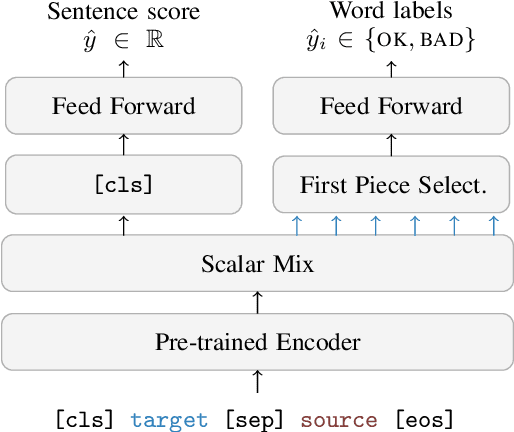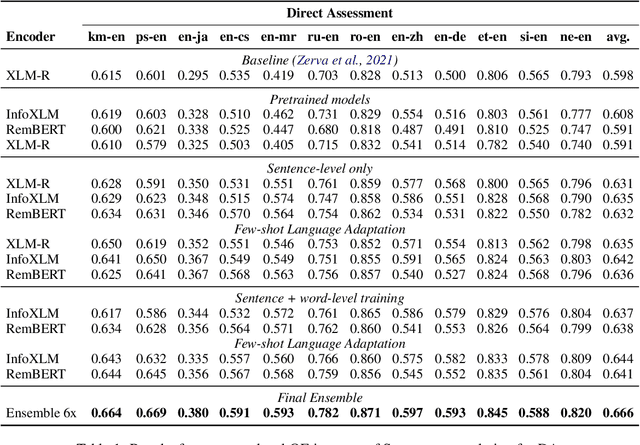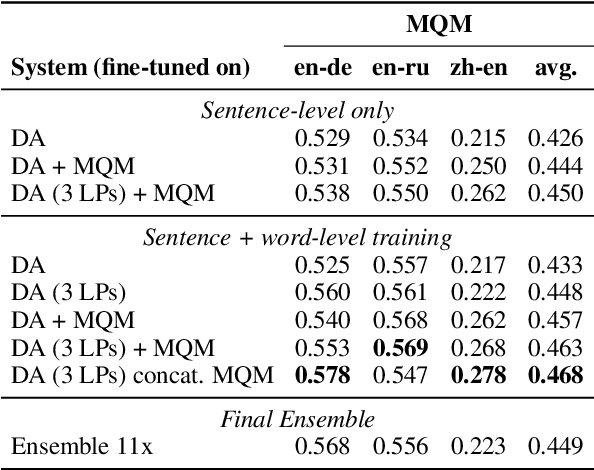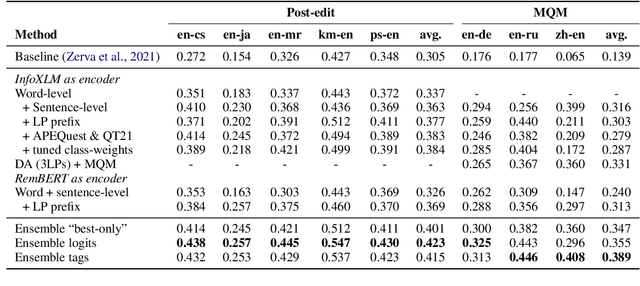Duarte M. Alves
EuroBERT: Scaling Multilingual Encoders for European Languages
Mar 07, 2025Abstract:General-purpose multilingual vector representations, used in retrieval, regression and classification, are traditionally obtained from bidirectional encoder models. Despite their wide applicability, encoders have been recently overshadowed by advances in generative decoder-only models. However, many innovations driving this progress are not inherently tied to decoders. In this paper, we revisit the development of multilingual encoders through the lens of these advances, and introduce EuroBERT, a family of multilingual encoders covering European and widely spoken global languages. Our models outperform existing alternatives across a diverse range of tasks, spanning multilingual capabilities, mathematics, and coding, and natively supporting sequences of up to 8,192 tokens. We also examine the design decisions behind EuroBERT, offering insights into our dataset composition and training pipeline. We publicly release the EuroBERT models, including intermediate training checkpoints, together with our training framework.
EuroLLM: Multilingual Language Models for Europe
Sep 24, 2024Abstract:The quality of open-weight LLMs has seen significant improvement, yet they remain predominantly focused on English. In this paper, we introduce the EuroLLM project, aimed at developing a suite of open-weight multilingual LLMs capable of understanding and generating text in all official European Union languages, as well as several additional relevant languages. We outline the progress made to date, detailing our data collection and filtering process, the development of scaling laws, the creation of our multilingual tokenizer, and the data mix and modeling configurations. Additionally, we release our initial models: EuroLLM-1.7B and EuroLLM-1.7B-Instruct and report their performance on multilingual general benchmarks and machine translation.
Tower: An Open Multilingual Large Language Model for Translation-Related Tasks
Feb 27, 2024



Abstract:While general-purpose large language models (LLMs) demonstrate proficiency on multiple tasks within the domain of translation, approaches based on open LLMs are competitive only when specializing on a single task. In this paper, we propose a recipe for tailoring LLMs to multiple tasks present in translation workflows. We perform continued pretraining on a multilingual mixture of monolingual and parallel data, creating TowerBase, followed by finetuning on instructions relevant for translation processes, creating TowerInstruct. Our final model surpasses open alternatives on several tasks relevant to translation workflows and is competitive with general-purpose closed LLMs. To facilitate future research, we release the Tower models, our specialization dataset, an evaluation framework for LLMs focusing on the translation ecosystem, and a collection of model generations, including ours, on our benchmark.
CroissantLLM: A Truly Bilingual French-English Language Model
Feb 02, 2024



Abstract:We introduce CroissantLLM, a 1.3B language model pretrained on a set of 3T English and French tokens, to bring to the research and industrial community a high-performance, fully open-sourced bilingual model that runs swiftly on consumer-grade local hardware. To that end, we pioneer the approach of training an intrinsically bilingual model with a 1:1 English-to-French pretraining data ratio, a custom tokenizer, and bilingual finetuning datasets. We release the training dataset, notably containing a French split with manually curated, high-quality, and varied data sources. To assess performance outside of English, we craft a novel benchmark, FrenchBench, consisting of an array of classification and generation tasks, covering various orthogonal aspects of model performance in the French Language. Additionally, rooted in transparency and to foster further Large Language Model research, we release codebases, and dozens of checkpoints across various model sizes, training data distributions, and training steps, as well as fine-tuned Chat models, and strong translation models. We evaluate our model through the FMTI framework, and validate 81 % of the transparency criteria, far beyond the scores of even most open initiatives. This work enriches the NLP landscape, breaking away from previous English-centric work in order to strengthen our understanding of multilinguality in language models.
Steering Large Language Models for Machine Translation with Finetuning and In-Context Learning
Oct 20, 2023Abstract:Large language models (LLMs) are a promising avenue for machine translation (MT). However, current LLM-based MT systems are brittle: their effectiveness highly depends on the choice of few-shot examples and they often require extra post-processing due to overgeneration. Alternatives such as finetuning on translation instructions are computationally expensive and may weaken in-context learning capabilities, due to overspecialization. In this paper, we provide a closer look at this problem. We start by showing that adapter-based finetuning with LoRA matches the performance of traditional finetuning while reducing the number of training parameters by a factor of 50. This method also outperforms few-shot prompting and eliminates the need for post-processing or in-context examples. However, we show that finetuning generally degrades few-shot performance, hindering adaptation capabilities. Finally, to obtain the best of both worlds, we propose a simple approach that incorporates few-shot examples during finetuning. Experiments on 10 language pairs show that our proposed approach recovers the original few-shot capabilities while keeping the added benefits of finetuning.
CometKiwi: IST-Unbabel 2022 Submission for the Quality Estimation Shared Task
Sep 13, 2022



Abstract:We present the joint contribution of IST and Unbabel to the WMT 2022 Shared Task on Quality Estimation (QE). Our team participated on all three subtasks: (i) Sentence and Word-level Quality Prediction; (ii) Explainable QE; and (iii) Critical Error Detection. For all tasks we build on top of the COMET framework, connecting it with the predictor-estimator architecture of OpenKiwi, and equipping it with a word-level sequence tagger and an explanation extractor. Our results suggest that incorporating references during pretraining improves performance across several language pairs on downstream tasks, and that jointly training with sentence and word-level objectives yields a further boost. Furthermore, combining attention and gradient information proved to be the top strategy for extracting good explanations of sentence-level QE models. Overall, our submissions achieved the best results for all three tasks for almost all language pairs by a considerable margin.
 Add to Chrome
Add to Chrome Add to Firefox
Add to Firefox Add to Edge
Add to Edge